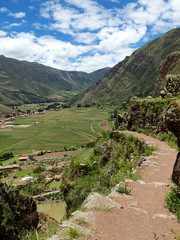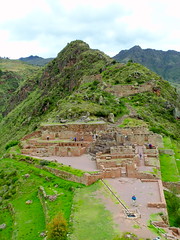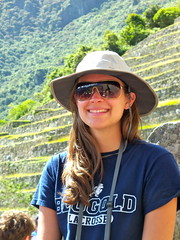
Director of KetzalCoatlicue, Susana de León, speaks to the audience about the group's traditional dress.
First we heard the jingling of the shells on their ankles, then we saw their headdresses adorned with colorful feathers, and shortly after that the Aztec dance group appeared from behind the curtains dancing to the steady beat of the sacred drum.
This past Friday I had the opportunity to attend the dance performance of an Aztec group from Minneapolis called KetzalCoatlicue. The group was featured during a series of events during Latin American Studies Week on the UWEC campus. The group’s director, Susana de León, and her troupe of six young dancers began the ceremony with an offering dance and went on to demonstrate various Aztec dances that have been passed on through oral tradition since their ancestors inhabited Mexico. León explained that each dance had a ceremonial purpose and that each of the dancers’ outfits were handmade by the dancers themselves. Each outfit is made of leather and embellished with feathers, shells and images related to stories passed on through oral tradition, and they are quite elaborate! The volunteer members of KetzalCoatlicue travel around the country to perform for audiences and to keep the tradition of dance alive and educate people about the Aztec culture.
About halfway through the performance, León invited audience members to join the group onstage and proceeded to teach them a short dance. As with the other dances, this dance included many quick steps and repeated series of steps, and she even tossed a few turns in there to spice it up a bit. Afterwards the group finished up their dances and ended the evening the same way they started, with an offering dance. Then the headdresses disappeared behind the curtains and the sound of the shells on their ankles subsided, leaving the audience in awe. The performance was full of youthful energy, and I suggest if you ever get the chance to see KetzalCoatlicue perform, you should definitely go. If you would like to read more about the group, visit their website at http://www.vfvaldez.com/kal/index.html.
Besos!
Megan
Have you ever attended a unique cultural performance? Share your individual experience in the Comments section below!










